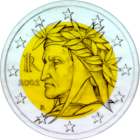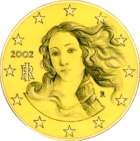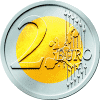Marco Polo Birthplace?
L'Angolo Del Presidente
Italiano per Stranieri
TERZA PAGINA
da Calle del Vento
Opere di Italiani
Proverbi e Animali
La Rondine is published monthly by The Italian Club of St. Louis
President
Editor
Franco Giannotti
Internet Edition

|
|
|
|
|
|
Recap of March Meeting:
Le Quattro Pieta` di Michelangelo Buonarroti
| A special note of thanks to Tony Perrone
for his marvelous presentation on the four pieta of Michelangelo and for
preparing the excellent English translation of his Italian-language lecture.
Thanks also, once again, to Peter Puleo for making the slides. Tony's
talk was particularly interesting with respect to possible psychological
implications of the fact that the artist never completed the last three
of the four works. We always receive highly favorable comments whenever
Professor Perrone speaks and this time was no exception.
An example is the following note from Roger Gennari "I thought Tony Perrone was so good at the last meeting. He captured the psychology of the various pietas so well. And the sonnet at the end so captured Michelangelo's struggle with art versus death and how even art does not save us from the ultimate pain. Powerful stuff and great." Anyone wishing to have a copy of Tony's talk (either English, Italian, or both), call Gene Mariani |
April Meeting:
|
|
|
|
Veramente, qui si parla italiano
The Club's March program presentation, given
by Professor Tony Perrone entirely in Italian (with English translation
provided), was something of an experiment to determine whether members
would like to have Italian-language programs. In a written survey following
the presentation people were asked to choose one of three statements. The
statements and summary of replies (n=38) are listed below. Obviously, we
will have additional programs in Italian .
|
Was Marco Polo Really Sicilian?
One of the more provocative tidbits presented by John Ferrara
in his talk on The History of Pasta at the February meeting was
the statement that Marco Polo was not a Venetian but was Sicilian.
When this was reported in the last issue of La Rondine, we received a letter
challenging the accuracy of John's comment.
Ed: We attempted to contact John for his comments. Unfortunately, he was away from the city and could not be reached. However, we will report further on this interesting situation in the next issue of La Rondine. |
||
Coming Programs at the
Instituto Italiano di Cultura
- Chicago.
| La Rondine will periodically publish a summary of coming programs at
the Istituto Italiano di Cultura in Chicago, the cultural representativ
e of the Italian Government, located at 500 North Michigan Suite 1450,
Chicago, Illinois (312-822-9545).
The Institute's full calendar of events may be seen by logging onto the Italian Club's website at and then hyperlinking to government organizations. Call Gene Mariani (352-5484) for more information. |
| April 2-5 Conference of the American Association of Italian Studies. Radisson Hotel (312) 787-2900. April 7 April 9 April 21 April 30 |
Paula Findlen Lecture
at Washington University
| Professor Paula Findlen, Professor of History at Stanford University will deliver a lecture entitled "Resisting the Muse: Women, Science and poetry in Enlightenment Italy. Professor Findlen is a noted expert on the history of science in Italy from the Renaissance through the Enlightenment. Her paper will present part of her current and semina l research on scientific women of the Italian Enlightenment. Friday, April 10. Women's Bldg. 3:00 PM |
Corsi Di Lingua E Cultura Italiana Per Stranieri
| "Un uomo che parla due lingue ne vale
due".
Once again, the University of Pisa will have courses for foreigners in Italian language and culture this summer at Viareggio. There will be two courses, 1 - 25 July and 3 - 27 August. For more information contact Segreteria Dei Corsi Per Stranieri, Dipartimento Di Linguistica. 36 Via S. Maria, 56126 Pisa, Italia . Tel. (50)24773/41478. Fax (50)44100. Email: gamba@ling.unipi.it Website: www.humnet.unipi.it/linguistica/summer.htm. For more information, call Gene Mariani at 352-5484. |
Giornali Italiani
| Se vuoi leggere dei giornali italiani sull' internet:
La Repubblica: (http://www.repubblica.it) Apparira' la pagina di notizie On-Line. Se vuoi leggere il giornale devi andare sul lato sinistro, dove c'e' scritto "Il quotidiano in edicola." Il Corriere della Sera: (http://www.rcs.it/corriere/benven.htm) |
| Click here for additional Italian newspapers and magazines |
Dalla Lira all'Euro
 euro
la nuova moneta dell'Europa. O, per meglio dire, di quei Paesi, come l'Italia,
che faranno parte dell'Unione Economica e Monetaria. Fra qualche anno non
ci saranno piu` lire italiane, franchi francesi , marchi tedeschi -- ci
saranno solo euro. euro
la nuova moneta dell'Europa. O, per meglio dire, di quei Paesi, come l'Italia,
che faranno parte dell'Unione Economica e Monetaria. Fra qualche anno non
ci saranno piu` lire italiane, franchi francesi , marchi tedeschi -- ci
saranno solo euro.
Il calendario della moneta unica: il primo gennaio, 2002, entreranno
in circolazione banconote e monete euro. Le banconote e monete nazionali
saranno ritirate dalla circolazione. Il primo luglio, 2002, le banconote
e monete in lire cesseranno di avere corso legale. Le monete saranno da 1, 2, 5, 10, 20, e 50 centesimi di euro (eurocent) e da 1 e 2 euro; una faccia sara` comune per tutti i Paesi membri, mentre l'altra sara` nazionale. I tagli delle banconote saranno sette: da 5 , 10, 20, 50, 100, 200, e 500 euro. Le banconote saranno uguali in tutti i Paesi. Le immagini rappresenteranno simbolicamente ponti e porte d'Europa, senza fare riferimento a monumenti reali. Le banconote avranno elementi in rilievo per essere identificate dai non vedenti. Per informazioni, rivolgersi all'internet: www.tesoro.it |
| Translation by Barbara Klein:
From Lira to Euro The euro is the new money of Europe, or, more precisely, for th ose countries, like Italy, that will become part of the European Economic Commun ity. In a few years, there will no longer be Italian lire, French francs, German marks -- there will be only euro. The timeframe for the new money is: on January 1, 2002, the euro bills and coins will enter into circulation and the governments will begin to withdraw from circulation their own bills and coins. After July 1, 2002, the Italian lira bills and coins will cease to have legal circulation.
For further information, go to the internet site: www.tesoro.i t |
|
|
|
da Calle del Vento
Quel pomeriggio dolce
si andava lungo il fiume.
E ci sorprese a un tratto,
dall'altra riva,
un vasto coro, un alto
rammarichìo di tortore selvagge
raccolte lì, chissà come, da quando.
Il bel fiume era l'Adda
errabonda per prati e campi,
tra leggiere boschine di pioppi.
Sopra era teso un cielo senza nubi,
appena nebuloso:
il bel cielo di Lombardia,
così bello, così in pace.
Diego Valeri (Piove di Sacco 1887 - Roma 1976
OPERE DI ITALIANI AL MUSEO DI ST. LOUIS
12. Giovanni Angelo da Montorsoli. Pan addormentato. (Marmo, circa 1533).
| Nella mitologia greca, Pan era figlio di Ermete Cillenio e della ninfa
Driope e padre dei satiri. Era il dio dei monti e dei campi, proteggeva
gli armenti, presiedeva al riposo meridiano, prediligeva i boschi, la musica
e la danza e veniva raffigurato parte uomo e parte capra, di cui aveva
le zampe e le corna. La scultura di Montorsoli, che faceva parte di una
fontana che ora non esiste più, lo rappresenta con scrupolosi dettagli
mentre riposa su una roccia circondato dagli elementi che fanno parte del
suo mito: la pelle di capra annodata intorno al collo, i grappoli d’uva,
le foglie di vite, una salamadra, un contenitore di vino, da cui un tempo
sgorgava un getto d’acqua che ha logorato il braccio della statua, e il
flauto, lo strumento da lui creato con le canne in cui era stata trasformata
la ninfa da lui perseguita. La statua è un magnifico esemplare di
scultura rinascimentale che per qualche tempo fu persino attribuita a Michelangelo,
di cui Montorsoli era un allievo molto apprezzato. Racconta il Vasari che
Michelangelo volle il Montorsoli come assistente durante i lavori nella
Cappella medicea, la tomba di Lorenzo e Giuliano de Medici a Firenze,
dove il Montorsoli scolpì S. Cosma.
Giovanni Angelo da Montorsoli, (Montorsoli, Firenze 1507 - Firenze 1563) fu anche collaboratore di Michelangelo nella realizzazione della tomba di A. Doria (Genova, chiesa di S. Matteo) e fu attivo anche a Napoli, Venezia, Padova e Messina. |
PERLE ITALIANE DELL’UNESCO
Queste sono le meraviglie d’Italia che si aggiungono alle meraviglie del mondo riconosciute dall’Unesco come patrimonio dell’umanità. La lista, che include 552 località (418 culturali, 114 naturali e 20 miste) in 112 paesi, sarà aggiornata durante la prossima riunione del comitato nel Dicembre 1998.
|
|
PROVERBI E ANIMALI
 Campa
cavallo che l’erba cresce. Campa
cavallo che l’erba cresce. |
The following hyperlinks to Italian sites have appeared in this issue:
|
|
Click on any of the above to establish the connection. Use the browser "back" button to return to La Rondine |

 The
coins will be in 1, 2, 5, 10, 20 and 50 eurocents and 1 and 2 euros; one
side of the coin will be common to all countries, while the other will
be individualized to the country. The denominations of the bills will be
5 , 10, 20, 50, 100, 200 and 500 euros. The bills will be similar in all
countries. The images will symbolically represent European bridges and
arches, without referring to actual monuments. The bills will have Braille
to make them easily identified by the blind.
The
coins will be in 1, 2, 5, 10, 20 and 50 eurocents and 1 and 2 euros; one
side of the coin will be common to all countries, while the other will
be individualized to the country. The denominations of the bills will be
5 , 10, 20, 50, 100, 200 and 500 euros. The bills will be similar in all
countries. The images will symbolically represent European bridges and
arches, without referring to actual monuments. The bills will have Braille
to make them easily identified by the blind.